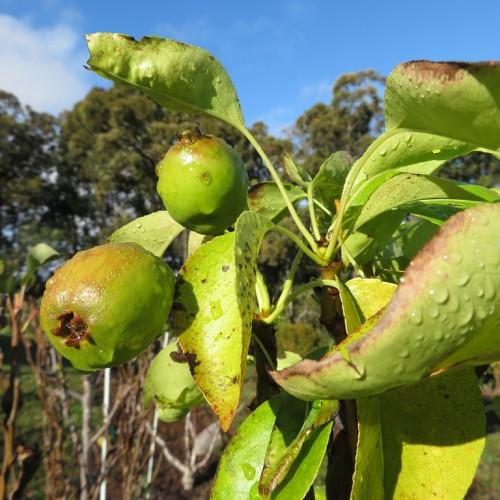
common pear
Pyrus communis
Also Known As - common pearCycle:
Perennial
Watering:
Average
Hardiness Zone:
4 - 8
Flowers:
Flowers
Sun:
Full sun
Soil:
Humus rich, Well-drained
Fruits:
Fruits In Summer Ready In Fall
Edible:
Yes
Leaf:
Yes
Growth Rate:
High
Maintenance:
High
Care Level:
Medium
watering
Water is key for Common Pear trees to grown and thrive. The plant should be watered deeply, allowing the water to soak into the soil in order to reach the deeper root system. During the first few years of growth, Common Pear trees should be watered once per week, allowing the soil to become slightly dry before watering again. Once the tree matures (after the first few years) it can be watered every 10 to 14 days, but water more frequently (every 5 to 7 days) during hot, dry summer periods. It is important to not overwater the tree, as too much water can lead to root rot or fungal diseases. A good way to tell if the soil is wet enough is to put your finger about an inch into the soil 2-3 inches away from the trunk. If the soil is damp or wet, you can wait a few days until it is slightly drier before watering again.
sunlight
For a Common Pear (Pyrus communis) to grow and thrive, it needs a minimum of 4 to 6 hours of direct sunlight each day. The ideal amount of direct sunlight exposure is 6 to 8 hours of direct sunlight throughout the day. Avoid exposing the plant to direct sunlight at midday as this can limit the amount of photosynthesis and fruit growth. In addition, providing adequate shade and ventilation to the plants can help them to better deal with the summer heat and keep them from becoming overly stressed.
pruning
Pruning common pear trees (Pyrus communis) is important for their health and growth. Pruning should typically take place in early spring before growth has begun. Pruning should remove any dead or diseased branches, and also shape the tree by removing suckers, crossing branches, and branches that are too low or too close together. Aim to remove no more than 1/4 to 1/3 of the total growth annually. Dead wood that has become overgrown can also be removed to invigorate growth. Finally, remove any fruiting wood that is more than 4 years old to allow young fruit-bearing wood to take its place.
